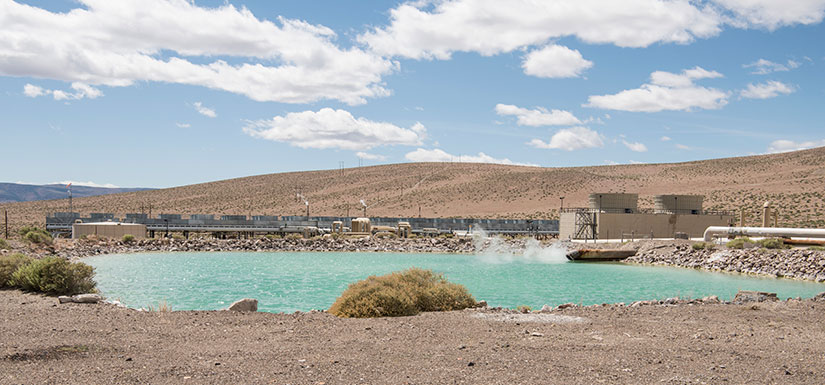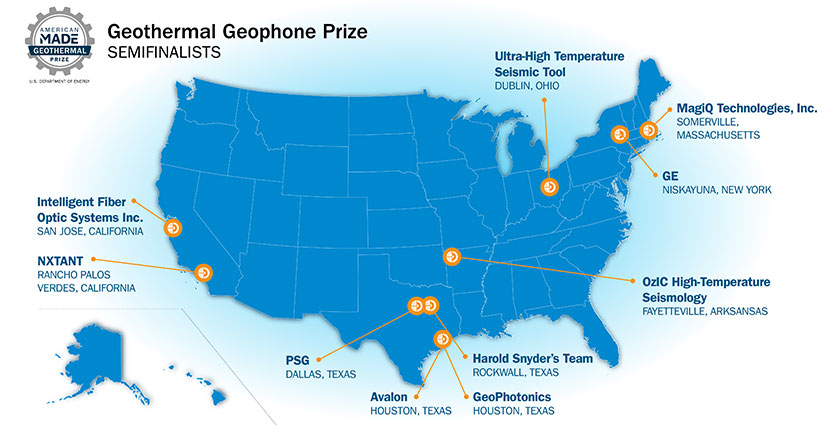Bring on the Seismic Noise
New Concepts for Downhole Sensor Technologies From American-Made Geothermal Geophone Prize Semifinalists Could Help Deploy Renewable Energy Across the United States

Ten teams have been named semifinalists in the American-Made Geothermal Geophone Prize, each earning $75,000 in cash prizes and $75,000 in vouchers for technical assistance to advance technologies that will help deploy the renewable energy supplied by the heat of the Earth.
Geophones are tools that scientists use to detect underground acoustic vibrations or listen for seismic noise, which is useful in a variety of applications and increasingly in geothermal reservoir monitoring. However, traditional seismic monitoring tools cannot easily withstand the high temperatures, high rock strengths, and corrosive working fluids in many of our hottest geothermal wells.
We are working on that though: The Geothermal Geophone Prize, part of the American-Made Challenges program and funded by the U.S. Department of Energy's Geothermal Technologies Office, is catalyzing the advancement of geophones that can withstand harsh geothermal environments.
The Challenge
Enhanced geothermal systems (EGS) have the potential to enable development of more than 60 gigawatts of renewable electricity capacity by 2050. The Geothermal Geophone Prize is designed to spark innovation and help the nation realize this potential by addressing the challenges of operating high-temperature, downhole-capable seismic monitoring for EGS.
Geophones collect rich data sets that provide information about subsurface geothermal reservoirs and how the reservoir rock is evolving before, during, and after geothermal operations. Geophones can be deployed at the surface or in wells that place them closer to geothermal reservoirs where they can collect more detailed data. The deeper the dig—geothermal reservoirs exist from 8,000 to over 12,000 feet underground—the more robust, sensitive, and heat resistant monitoring tools need to be. High temperatures, exceedingly dense rock formations, and corrosive working fluids present roadblocks for analyzing geothermal wells.
Geothermal Geophone Prize Semifinalists
In Phase 1 of the prize, competitors were asked to identify and develop an initial concept for a high-temperature, downhole seismic sensor utilizing currently available components. Phase 1 winners are illustrated in the map, and their concepts are described below.

-
Avalon (Houston, Texas): Chirped Laser Geophone for Geothermal Boreholes—An optical geophone designed to withstand high temperatures
-
GE (Niskayuna, New York): GE MEMS [Micro-Electro-Mechanical System] Downhole Geophone—Dual vibrating beam, high-temperature, and lower cost accelerometer
-
GeoPhotonics (Houston, Texas): Optical MEMS & Geothermal Seismology—All-fiber MEMS cantilever solution
-
Harold Snyder's Team (Rockwall, Texas): Geothermal 3-Axis Accelerometer Microseismic Tool—Higher-sensitivity microseismic and 3D-printed accelerometer
-
Intelligent Fiber Optic Systems Inc. (San Jose, California): The GeoSense Solution—Addresses sensor and temperature challenges, with added data analytics
-
MagiQ Technologies Inc. (Somerville, Massachusetts): ThermaView Optical Seismic for Smart Geothermal—Newly advanced signal processing system, equipped with a smaller, more rugged accelerometer tool design
-
NXTANT (Rancho Palos Verdes, California): NXTANT—Project EAGLE is an advanced MEMs accelerometer designed with both aerospace and underwater technologies
-
OzIC High-Temperature Seismology (Fayetteville, Arkansas): High-Temperature LVDT-based Geophone—Offers a newly designed tool featuring advanced manufacturing components
-
PSG (Dallas, Texas): Photonic Seismometer for Geothermal Applications—New triaxial optical concept offering high temperature and pressure solutions
-
Ultra-High Temperature Seismic Tool (Dublin, Ohio): Ultra-High Temperature Seismic Tool—Combines advanced aerospace circuitry with proven oil and gas tooling.
What Is Next
During Phase 2, teams will advance their concepts and demonstrate the promise of their designs. Phase 2 is also open to interested parties who did not participate in Phase 1. Submissions for Phase 2 are due in October 2023. For more info, follow the Geothermal Geophone Prize on HeroX.
The Geophone Prize is part of the American-Made Challenges (AMC) program. Other geothermal prizes in the AMC include the Geothermal Lithium Extraction Prize, currently in Phase 3, and the recent Geothermal Manufacturing Prize, for which the Geothermal Technologies Office selected winners in August.
Last Updated May 28, 2025
